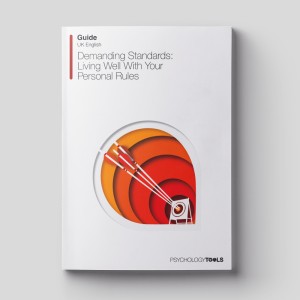"Should" Statements
“Should” statements (sometimes referred to as ‘musturbation’, ‘necessitous thinking’, ‘self-commands’, and ‘injunctions’) are characterized by imposing fixed ‘rules’ on how the self, others, and the world should operate, coupled with overestimations of how awful it would be if these expectations are not met. They are a common cognitive distortion or ‘unhelpful thinking style’ and terms such as “should”, “must”, and “ought to” often appear in this style of thinking. The “Should” Statements information handout forms part of the cognitive distortions series, designed to help clients and therapists to work more effectively with common thinking biases.
Download or send
Related resources
Tags
Languages this resource is available in
Problems this resource might be used to address
Techniques associated with this resource
Mechanisms associated with this resource
Introduction & Theoretical Background
A brief introduction to cognitive distortions
Cognitive distortions, cognitive biases, or ‘unhelpful thinking styles’ are characteristic ways in which our thoughts can become biased (Beck, 1963). As conscious beings we are always interpreting the world around us, trying to make sense of what is happening. Sometimes our brains take ‘short cuts’ and we think things that are not completely accurate, and different cognitive short cuts result in different kinds of bias or distortions in our thinking. Sometimes we might jump to the worst possible conclusion (“this rough patch of skin is cancer!”), at other times we might blame ourselves for things that are not our fault (“If I hadn’t made him angry he wouldn’t have hit me”), and at other times we might rely on intuition and jump to conclusions (“I know that they all hate me even though they’re being nice”).
Different cognitive biases are associated with different clinical
Therapist Guidance
Many people struggle with “should” statements. It sounds as though this might also be relevant to you. Would you be willing to explore it with me?
Clinicians may consider giving clients helpful psychoeducation about automatic thoughts more generally and “should” statements in particular. Consider sharing some of these important details:
- Automatic thoughts spring up spontaneously in your mind in the form of words or images.
- They are often on the ‘sidelines’ of our awareness. With practice, we can become more aware of them. It is a bit like a theatre – we can bring our automatic thoughts ‘center stage’.
- Automatic thoughts are not always accurate: just because you think something, it doesn’t make it true, and they are often inaccurate in characteristic ways.
- A common type of bias that can show up in our automatic thoughts are “should” statements. In other words, we use fixed rules to judge or
References And Further Reading
- Beck, A. T. (1963). Thinking and depression: I. Idiosyncratic content and cognitive distortions. Archives of General Psychiatry, 9, 324-333. DOI: 10.1001/archpsyc.1963.01720160014002.
- Beck, A. T., Rush, A. J., Shaw, B. F., & Emery, G. (1979). Cognitive therapy of depression. Guilford Press.
- Beck, J. S. (1995). Cognitive behavior therapy: Basics and beyond. Guilford Press.
- Blake, E., Dobson, K. S., Sheptycki, A. R., & Drapeau, M. (2016). The relationship between depression severity and cognitive errors. American Journal of Psychotherapy, 70, 203-221. DOI: 10.1176/appi.psychotherapy.2016.70.2.203.
- Brown, G., & Beck, A. T. (1989). The role of imperatives in psychopathology: A reply to Ellis. Cognitive Therapy and Research, 13, 315-321. DOI: 10.1007/BF01173476.
- Branch, R., & Wilson, R. (2020). Cognitive behavioural therapy for dummies (3rd ed.). John Wiley and Sons.
- Burns, D. D. (2020). Feeling great: The revolutionary new treatment for depression and anxiety. PESI Publishing.
- Darvishi, E., Golestan, S., Demehri, F., & Jamalnia, S. (2020). A





